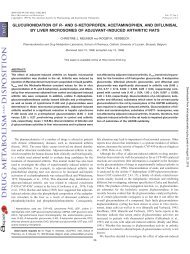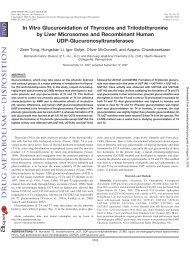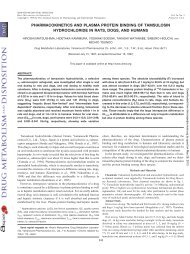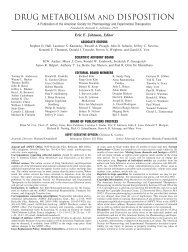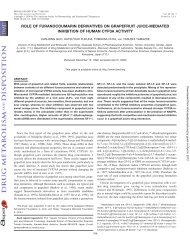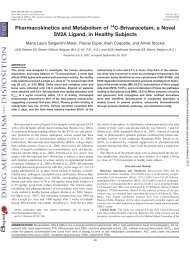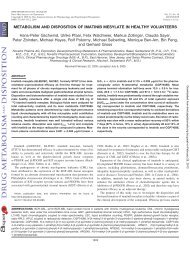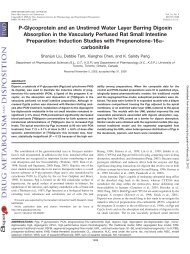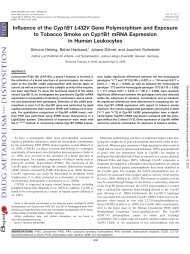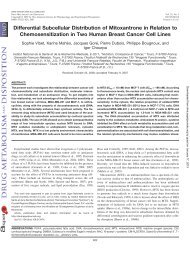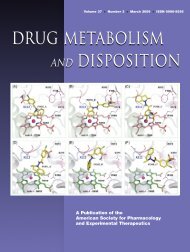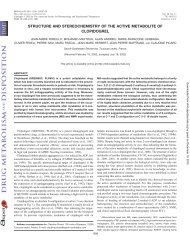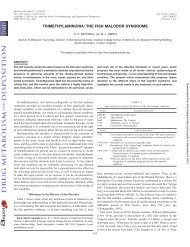development of an in vitro screening model for the biosynthesis of ...
development of an in vitro screening model for the biosynthesis of ...
development of an in vitro screening model for the biosynthesis of ...
You also want an ePaper? Increase the reach of your titles
YUMPU automatically turns print PDFs into web optimized ePapers that Google loves.
FIG. 4.Nonl<strong>in</strong>ear regression <strong>an</strong>alysis <strong>of</strong> <strong>the</strong> degradation <strong>of</strong> <strong>the</strong> whole acyl glucuronide (top) <strong>an</strong>d appear<strong>an</strong>ce <strong>of</strong> aglycone (bottom) dur<strong>in</strong>g <strong>in</strong>cubation at 37°C with<br />
HSA, pH 7.4.<br />
, tolmet<strong>in</strong>; f, zomepirac; Œ, ketopr<strong>of</strong>en; ‚, fenopr<strong>of</strong>en; F, supr<strong>of</strong>en; E, furosemide; , dicl<strong>of</strong>enac; ✳, ibupr<strong>of</strong>en.<br />
c<strong>an</strong>not be assessed <strong>in</strong> a screen<strong>in</strong>g process. Fur<strong>the</strong>rmore, HSA rema<strong>in</strong>s<br />
<strong>the</strong> prote<strong>in</strong> most extensively studied. It is widely distributed <strong>in</strong> <strong>the</strong><br />
plasma compartment <strong>an</strong>d easily related to <strong>the</strong> immune system. The<br />
knowledge ga<strong>the</strong>red on covalent b<strong>in</strong>d<strong>in</strong>g <strong>of</strong> acyl glucuronide <strong>an</strong>d HSA<br />
allowed <strong>the</strong> comparison <strong>an</strong>d validation <strong>of</strong> <strong>the</strong> results achieved with<br />
this <strong>model</strong>. A product show<strong>in</strong>g a signific<strong>an</strong>t covalent b<strong>in</strong>d<strong>in</strong>g to HSA<br />
<strong>in</strong> our <strong>model</strong> will require specific attention dur<strong>in</strong>g <strong>the</strong> <strong>development</strong><br />
process. The const<strong>an</strong>t values calculated <strong>for</strong> <strong>the</strong> disappear<strong>an</strong>ce <strong>of</strong> acyl<br />
glucuronides were lower th<strong>an</strong> those previously published, especially<br />
<strong>for</strong> zomepirac <strong>an</strong>d tolmet<strong>in</strong> (Hasegawa et al., 1982; Oj<strong>in</strong>gwa et al.,<br />
1994). In fact, those reported values represented <strong>the</strong> global degradation<br />
<strong>of</strong> 1-O-acyl glucuronide (hydrolysis isomerization), whereas<br />
<strong>the</strong> values presented <strong>in</strong> this study only represent <strong>the</strong> degradation <strong>of</strong><br />
isomeric <strong>for</strong>ms. In <strong>the</strong> conditions <strong>of</strong> <strong>an</strong>alysis described here, <strong>the</strong> exact<br />
IN VITRO ASSESSMENT OF ACYL GLUCURONIDE REACTIVITY<br />
TABLE 2<br />
Apparent first-order degradation <strong>of</strong> various acyl glucuronides <strong>an</strong>d aglycone<br />
appear<strong>an</strong>ce const<strong>an</strong>ts measured dur<strong>in</strong>g <strong>in</strong>cubation phases with 0.5 mM HSA, pH<br />
7.4, at 37°C<br />
Me<strong>an</strong> S.D. (n 3).<br />
Compound Name Acyl Glucuronide Degradation Rate Aglycone Appear<strong>an</strong>ce Rate<br />
Tolmet<strong>in</strong> 0.055 0.020 0.106 0.049<br />
Zomepirac 0.025 0.008 0.103 0.027<br />
Supr<strong>of</strong>en 0.046 0.021 0.035 0.018<br />
Dicl<strong>of</strong>enac 0.050 0.016 0.081 0.023<br />
Fenopr<strong>of</strong>en 0.021 0.014 0.044 0.011<br />
Ibupr<strong>of</strong>en 0.028 0.003 0.037 0.013<br />
Ketopr<strong>of</strong>en 0.037 0.010 0.016 0.005<br />
Furosemide 0.006 0.011 0.000 0.001<br />
h 1<br />
409<br />
Downloaded from<br />
dmd.aspetjournals.org by guest on May 29, 2013



